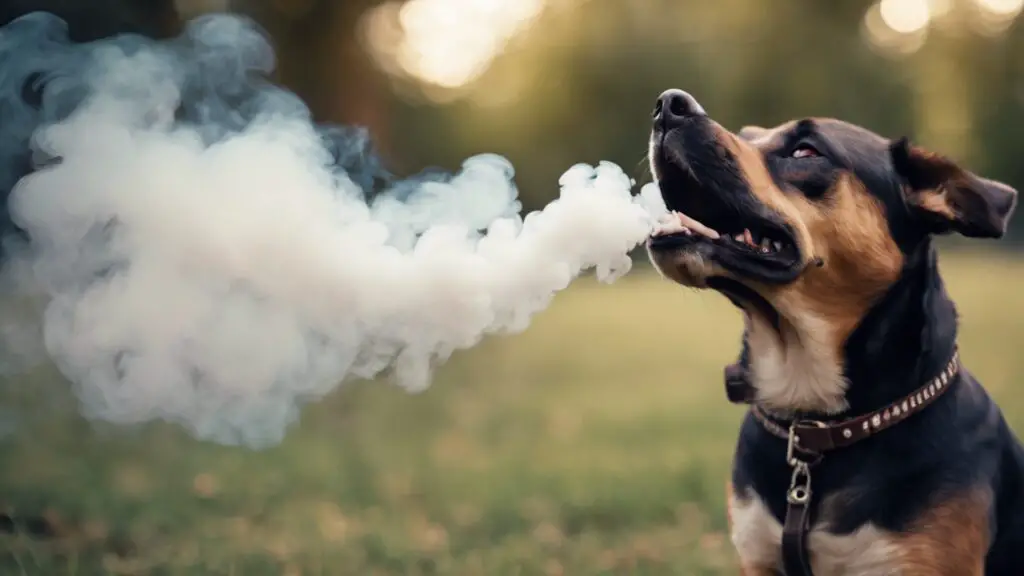
Blowing smoke in a dog’s face can potentially be fatal due to the harmful effects of nicotine and toxins. This act can lead to various health problems and even death in dogs.
The nicotine in cigarettes and other chemicals found in smoke can cause respiratory distress, lung damage, and even cancer in dogs.
Exposing dogs to secondhand smoke, including blowing smoke directly into their faces, is extremely harmful and should be avoided at all costs.
It is essential to prioritize the health and well-being of our canine companions by providing them with a smoke-free environment.
Understanding the Effects of Blowing Smoke in a Dog’s Face
Blowing smoke in a dog’s face can have serious consequences and potential risks. It is crucial to understand the effects it can have on dogs.
Immediate reactions and symptoms may include coughing, sneezing, wheezing, and difficulty breathing. The toxins present in the smoke can irritate the dog’s respiratory system and lead to long-term health problems.
Dogs have a sensitive sense of smell, and the smoke’s odor can cause discomfort and anxiety. Additionally, secondhand smoke can increase the risk of lung cancer and respiratory diseases in dogs, just as it does in humans.
It is important to provide a safe environment for our furry friends and avoid blowing smoke in their faces.
By considering their well-being, we can ensure their optimal health and happiness.
Myths Debunked: Separating Fact From Fiction
While many believe that blowing smoke in a dog’s face can be deadly, this is a myth. Studies have shown that dogs can tolerate small amounts of secondhand smoke without suffering any severe health effects.
However, that doesn’t mean exposing them to smoke regularly is safe.
Like humans, dogs can experience respiratory issues if constantly exposed to smoke. Additionally, dogs with certain health conditions, such as asthma or allergies, may be more sensitive to the harmful effects of smoke.
Therefore, it’s important to avoid blowing smoke near your furry friends and provide them with a smoke-free environment.
Don’t let myths cloud your judgment – prioritize your dog’s well-being and keep them away from smoke. If you’re wondering about the effects of various stimuli on your furry friend, you might also be curious, “Do car rides make dogs sleepy?”
The Dangers of Secondhand Smoke for Dogs
Secondhand smoke poses significant dangers to dogs, potentially leading to long-term consequences and life-threatening conditions.
Regular exposure can cause respiratory issues, including bronchitis, asthma, and pneumonia. The toxic chemicals in cigarette smoke can also damage a dog’s delicate lung tissues.
Furthermore, the risk of developing lung cancer increases substantially for dogs living in smoky environments. Dogs are particularly susceptible to the harmful effects of secondhand smoke due to their smaller lung capacity and faster respiration rate than humans.
In addition to respiratory problems, secondhand smoke can lead to cardiovascular issues and worsen existing health conditions in dogs, such as allergies and heart disease.
It is crucial to prioritize the well-being of our furry companions by creating smoke-free environments for them.

Smoke Inhalation in Dogs: Recognizing the Signs
Dogs may exhibit certain signs indicating inhaled smoke, including difficulty breathing, coughing, wheezing, and excessive panting.
Moreover, they may display behavioral changes such as restlessness, agitation, and disorientation. If you notice any of these symptoms in your dog, it is essential to seek immediate veterinary assistance.
Timely intervention can save their life and prevent serious long-term health issues.
Remember to carefully observe your pet’s condition and communicate these observations to your veterinarian. Doing so can help ensure your dog receives the necessary treatment and care they need.
Awareness of the signs of smoke inhalation and seeking professional help promptly is crucial for your furry friend’s safety and well-being.
Treatments and First Aid for Smoke Inhalation
Blowing smoke in a dog’s face can potentially harm them, but it is unlikely to be fatal in most cases. However, smoke inhalation can cause serious health issues, and prompt treatment is crucial.
If your dog has been exposed to smoke, you can take a few steps at home before visiting the veterinarian.
First, remove your dog from the source of the smoke and into fresh air. Keep them calm and monitor their breathing. It is essential not to administer home remedies without professional guidance, as they may be harmful.
Once you arrive at the vet, they will assess your dog’s condition and provide appropriate treatments, including oxygen therapy, nebulization, or bronchodilators.
In severe cases, hospitalization might be necessary for close monitoring and supportive care. Remember, immediate action and seeking veterinary help are vital for ensuring your dog’s well-being.
Prevention Is Key: Protecting Your Dog From Cigarette Smoke
Preventing smoke exposure is crucial in safeguarding your dog’s health and well-being. By implementing precautions and creating a smoke-free environment, you can protect them from the harmful effects of cigarette smoke.
Smoke contains toxins that can lead to respiratory issues, allergies, and even cancer in dogs.
Keep your dog away from smokers and designated smoking areas, and ensure proper ventilation in your home. Regularly clean and air out your living spaces to eliminate lingering smoke particles.
Additionally, consider using air purifiers and non-toxic cleaning products to create a healthier atmosphere for your furry friend.
Prevention is key to preserving your dog’s overall health and providing a happy and smoke-free environment. While discussing potential dangers to your canine companion, another important question to consider is, “Are Orbeez toxic to dogs?” We delved into the potential risks associated with these popular children’s toys and how they may affect your pet.
Alternatives to Blowing Smoke: Healthy Interaction With Dogs
Finding alternatives to blowing smoke in a dog’s face is essential for a healthy interaction with our pets. It is important to explore safer and more enjoyable ways to bond with our dogs.
The way to go is to engage in activities that strengthen our connection without endangering their health.
We can opt for games like fetch or hide-and-seek that provide mental and physical stimulation. Going for walks or hikes together not only encourages exercise but also allows for quality time outdoors.
Teaching them new tricks or commands through positive reinforcement is another great way to interact.
Regular grooming sessions can create a soothing and relaxing experience for the dog and the owner.
Conclusion
Blowing smoke in a dog’s face can have serious consequences and potentially cause harm or even death to our beloved furry friends. Dogs are highly sensitive to the toxins present in smoke, which can irritate their sensitive respiratory systems.
The harmful chemicals present in smoke can lead to respiratory distress, lung damage, and even cancer in dogs.
It is crucial for dog owners to be aware of the dangers of exposing their pets to smoke and take necessary precautions to create a smoke-free environment.
Instead of subjecting our dogs to these harmful effects, we should focus on providing them with a safe and healthy environment, regular exercise, and proper nutrition to ensure their well-being.
By understanding and respect the respiratory sensitivity of dogs, we can ensure their longevity and keep them happy and healthy companions in our lives.

![Do Car Rides Make Dogs Sleepy? [Discover Why?]](https://farrypet.com/wp-content/uploads/2023/08/Do-Car-Rides-Make-Dogs-Sleepy-768x432.jpg)




